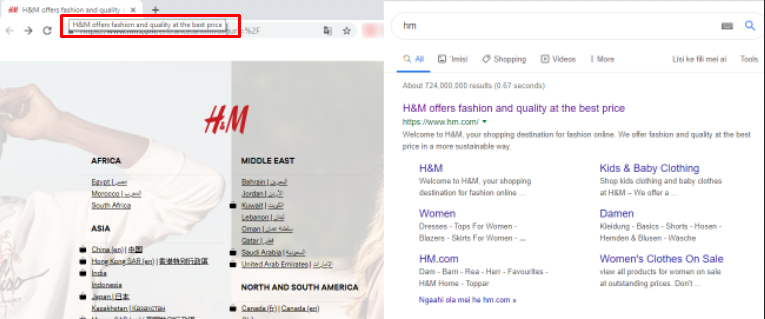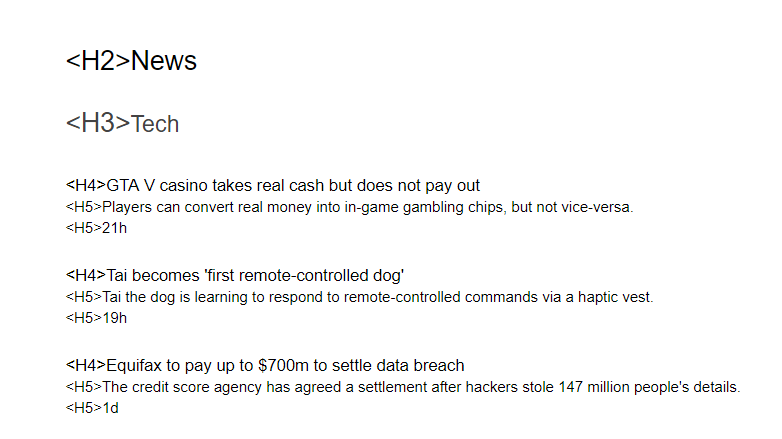Briefly about H1 — H6 headers
The headings perform several functions: improve the navigation on the page, make the text enjoyable and readable. Good headlines are convenient for users and help to improve the ranking of the article in search results. Otherwise, there is a high probability of losing the rating or not reaching the target audience.
The incorrectly formed html header is challenging to analyze. Search robots cannot determine which query group the page belongs to. Homonyms are difficult to analyze because of their significance. For example, the title "How to set up a factory" will be shown by search engines in a general report about a factory as an enterprise, and not a device for launching a mechanism.
Write the headers as html tags from <h1> to <h6>. They are responsible for page structure and are ranked by priority.
<H1> — a first level heading, it heads the text and is written at the beginning of the page. It is analyzed by the search engines at first. <H6> — the h tag with the lowest priority.
Thanks to these tags, search engines understand better what content is presented on the site, and more accurately select the answer to a search query. Proper design of the headers is able to raise the page in the top issue.
The <H1> header rules
The <H1> tag is the heading from which the article begins. Its task is to show the reader: there is exactly that information on the page he was looking for. The tag is required for SEO optimization, but primarily aimed at the user.
The <H1> header should not duplicate the Title
The Title tag is the actual name of the page. It is displayed at the top of the browser and is shown in the organic issue. There is a misconception that Title and <H1> should be identical. But it is not.

The <H1> and Title tags should be similar
They should not be duplicated, but the header text should not be much different from the Title. This leads to a deterioration of behavioral factors and a strong drop in positions in organic matter. The search engines find it difficult to determine which keywords a page belongs to and which queries should be answered.
To prevent a similar result, headers and Title should be similar, but at the same time not be repeated. More detailing keywords can be added to the Title without sacrificing meaning. Example:
Title: How to draw a tattoo: tips, information, rules, options.
H1: How to draw a tattoo.
Title: The ballet "La Bayadere": content, interesting facts, videos, history.
H1: "La Bayadere" ballet. Short synopsis.
Headers should not have a lot of keywords
Headlines should look organic. It is better not to use more than two or three keywords to preserve readability.
There is no need to use more than one <H1> tag per page
If you use the tag more than once, its significance will fall. As a result, the search engines will lower the ranking of a page or the entire site.
Don't make the <H1> header too long
Sometimes the <H1> tag tries to enter all the text to use more keywords. As a result, the headline is heavy and subject to sanctions.
Example:
<h1> How to buy a Ford Focus without paying for customs clearance of a car? How not get caught and what threatens the purchase of cars on the European license plate? Avoiding customs payments is carried out by temporary importation or use of the transit regime. </H1>
With such a header, the site will likely make an error when the header is displayed, and all technical information will appear in the text. In addition, the search engines may find this SEO header to be spam.
SEO specialists' recommendations on this topic are quite diverse. Some argue that the length of H1 should not exceed eight words, others advise to limit to 50 characters.
How to use <h1> — <h6> headers
1. Observe the hierarchy.
Tags must be used on the page in order, starting with <h1>. You must not allow the lower level heading to be higher than the high level (for example, <h3> above <h2>). Search robots, analyzing pages with the wrong structure, spend more crawling budget and time than on a structured page. As a result, the rating is reduced.
2. Do not use the links in headlines.
You can lead readers from the page to other material. If the link redirects back to the same page, then you loop it. Search robots perceive it as a twist of traffic and lower the position in the issuance.
3. Keep track of the readability and information content of the <h1> — <h6> headings.
Headings h must be readable, consistent with the text of the article. Search engines are always positively perceived, clearly formulated, and humanely written text. Tags <h1> — <h6> should be understandable. Their goal is to describe the essence of the article without unnecessary turnovers and sentences that make the title heavier. Short and to the point.
4. Remove unnecessary characters and tags in the headers.
The body of the headers should contain only text. The extra characters prevent search engines from analyzing them. The chance of an error increases, pieces of font tags or other technical information may appear in the header. The result — a deterioration in the reputation of visitors.
Example:
<h2 style = "color: # ff0000" align = "center"> 10 reasons to fix the plumbing by yourself. </ h2>
5. Do not create too many headers.
A large number of h tags of different levels is justified only in long reading. In any other case, oversaturation of article headings leads to spamming and reducing the importance of each heading. Google and other search engines will identify such pages as non-informative.

What should be present in H1
Since the H1 header must be similar to the Title and differ slightly from it, in H1 you can use a less frequency query that does not fit in the Title.
It is also important to prevent spamming using keywords and take into account that too large differences between H1 and Title may lead the search engine to consider the article irrelevant to the user's request.
Conclusion
- Use only one <h1> header.
- Do not forget about the hierarchy of tags <h1> — <h6>.
- The Header should intersect with the Title in the meaning, but not duplicate it.
- Make headlines clear, informative and readable.
- Do not spam text with <h1> — <h6> tags.
